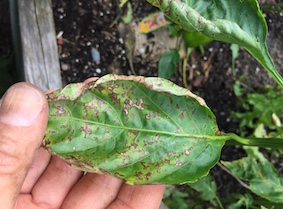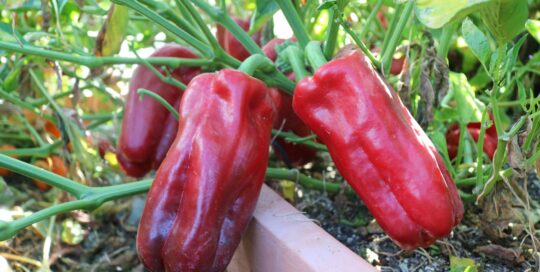Bacterial Leaf Spot on Pepper
Views: 11845

This year’s gardening season has been pretty successful. We’ve had the right balance of rain and sun. I’ve applied fertilizer routinely, so the plants look robust. The tomatoes have especially benefited from two applications of a tomato-specific fertilizer. And most of the pests have been kept away by regular, sometimes daily, application of the Captain Jack’s Deadbug Brew (see last post). The gardens look good. Except possibly the presence of Bacterial Leaf Spot on some peppers.
However, one problem has developed in a garden I consult on weekly. Several of the pepper plants have developed small, round brownish spots. The leaves eventually turn yellow and fall off, those on the bottom of the plant dropping first. It had actually been two weeks since I had seen the garden last, and during that time the difference in growth between those with the spots and those without was significant. For example, the jalapeño plants—not affected with spots—were lush with dark green leaves and twice the size of the spotted plants, which are a few different varieties of bell pepper. The fruit on the jalapenos were normal size, while the spotted plants had just a few fruits which were undersized.
What Is It?
Doing a bit of online research I concluded that the pepper plants are infected with bacterial leaf spot (BLS). How did these plants acquire it? Great question. There are three possibilities:
- It’s possible the bacterium that causes the leaf spots already infected the seeds. And since I purchased these plants as transplants from a home improvement store, the plants probably already had an infection before planting in the garden.
- The soil in the raised bed where I planted these may have the infection. Since this is my first time consulting here, I can’t be sure what was planted in this bed in previous years. Possibly, someone planted infected peppers here, and the infected leaf debris is still breaking down, hence passing along the disease to these plants.
- It’s possible dirty tools carrying the bacterium passed on the disease. Since I planted these plants using a trowel, that trowel could have passed the bacterium from another garden to this once. This is my least likely scenario because the disease is not present in any of the other gardens in which I work.
Why are some plants affected and some not? There are certain pepper varieties that are resistant to BLS, and I’m guessing these jalapeños are resistant.
What To Do About It?
Once the plants are infected there is no cure. The best bet is to remove the pepper plants and any leaf debris they have left behind from the garden and throw it all in the trash. That lessens the amount of the bacterium left behind in the soil. This always helps to prevent the disease from affecting the pepper relatives tomatoes and eggplant.
The work doesn’t stop with removal! Till the soil in this area extra well to help the decomposition process of any remaining plant debris. At the beginning of the next growing season do make a note of where these peppers were located and DO NOT PLANT peppers, tomatoes and eggplant in that area for three to four years.
Meet Ellen Wells
When you’re raised on a farm, you can’t help but know a thing or two about gardening. Ellen Wells is our expert on edible gardening.…
Ellen's Recent Posts

Pepper Red Impact an All-America Selections Winner






